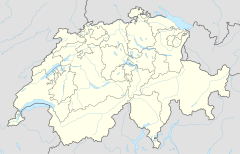
The Harderbahn (HB) is one of two funiculars that operate from the town of Interlaken. The Harderbahn leads to the western end of the Harder in the north of Interlaken across the river Aare, in Switzerland.

The Brienz Rothorn Railway is a tourist rack railway in Switzerland, which climbs from Brienz, at the eastern end of Lake Brienz, to the summit of the Brienzer Rothorn. The railway is 7.6 kilometres (4.7 mi) long, is built to 800 mm gauge, and uses the Abt double lamella rack system. Unusually for Switzerland, the line is not electrified, and most trains are operated by steam locomotives.

The Schynige Platte Railway is a mountain railway in the Bernese Highlands area of Switzerland, which connects the town of Wilderswil, near Interlaken, with the famous wildflower gardens of the Schynige Platte.

The Bernese Oberland Railway is a narrow-gauge mountain railway in the Bernese Oberland region of Switzerland. It runs, via a "Y" junction at Zweilütschinen to serve Lauterbrunnen and Grindelwald from Interlaken. The railway is rack assisted.

Wilderswil is a village and a municipality in the Interlaken-Oberhasli administrative district in the canton of Bern in Switzerland.

Wilderswil railway station is a railway station in the village and municipality of Wilderswil in the Swiss canton of Bern. The station is on the Berner Oberland Bahn, whose trains operate services to Interlaken Ost, Grindelwald and Lauterbrunnen. It is also the valley terminus of the Schynige Platte Railway, whose trains operate to the Schynige Platte and are stabled at a depot bordering the station.

Gsteigwiler is a municipality in the Interlaken-Oberhasli administrative district in the canton of Bern in Switzerland.
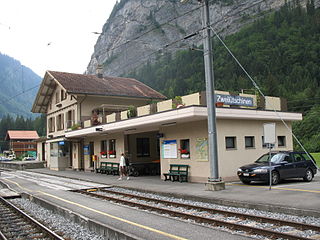
Gündlischwand is a village and municipality in the Interlaken-Oberhasli administrative district in the canton of Bern in Switzerland. Besides the village of Gündlischwand, the municipality also includes the hamlet of Zweilütschinen.

The Schynige Platte is a small mountain ridge and a viewpoint in the Bernese Highlands and belongs to the Schwarzhorn group. The mountain range consists of three peaks: Gumihorn, Tuba, and the closest summit next to the viewpoint, Geiss. The viewpoint lies at an altitude of about 2,000 metres (7,000 ft), at the western end of a prominent ridge of the Schwarzhorn group, which separates the valley of the Schwarze Lütschine from Lake Brienz.

Lütschental railway station is a railway station in the village and municipality of Lutschental in the Swiss canton of Bern. The station is on the Berner Oberland Bahn, whose trains operate services to Interlaken Ost and Grindelwald.

Winteregg is a railway station on the Bergbahn Lauterbrunnen-Mürren, a hybrid cable car and rail link that connects the villages of Lauterbrunnen and Mürren in the Bernese Oberland region of Switzerland. Winteregg is the point at which trains on the rail link between Lauterbrunnen and Mürren pass.

Neuhausen is a railway station served by S-Bahn services in the municipality of Neuhausen am Rheinfall, in the Swiss canton of Schaffhausen.
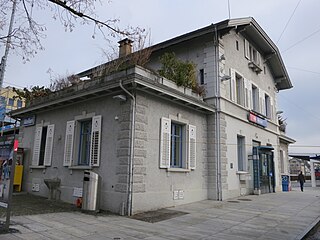
Meilen is a railway station in the Swiss canton of Zürich, situated in the municipality of Meilen. The station is located on the Lake Zürich right bank railway line.
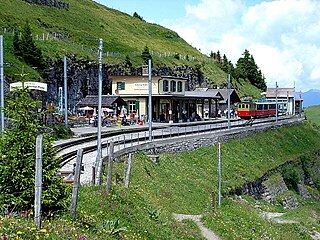
Schynige Platte is a railway station that is the upper terminus of the Schynige Platte railway, a rack railway that connects Wilderswil with the Schynige Platte mountain in the Bernese Oberland region of Switzerland. The Schynige Platte alpine botanical garden is accessed from the station, whilst a mountain hotel and restaurant is nearby.

The Sihltal railway line is a railway line in the Swiss canton of Zürich, which connects the city of Zürich with the communities of the Sihl Valley. Passenger service on the line now forms part of the Zürich S-Bahn, branded as that network's service S4, and is part of the Zürcher Verkehrsverbund (ZVV) zone-based fare network.

The Schynige Platte Alpine Garden is a botanical garden located at an altitude of about 2,000 metres (7,000 ft), near the summit of the Schynige Platte mountain in the Bernese Oberland region of Switzerland. It specialises in research into the high altitude flora of Switzerland, and has a display of over 600 species of plants native to the Swiss Alps. The garden is run by the Schynige Platte Alpine Garden Society, working closely with the Botanical Garden of Bern and the Institute for Plant Sciences at the University of Bern.

The Bern–Schwarzenburg railway line is a railway line in Switzerland. It was built by the Bern-Schwarzenburg-Bahn. It was opened on 1 June 1907 between Bern and Schwarzenburg.

On 3 June 2022, a double decker regional train derailed north of Garmisch-Partenkirchen, near Burgrain on the Munich–Garmisch-Partenkirchen railway in southern Germany. Five people died and 68 passengers were injured, 16 of them seriously.
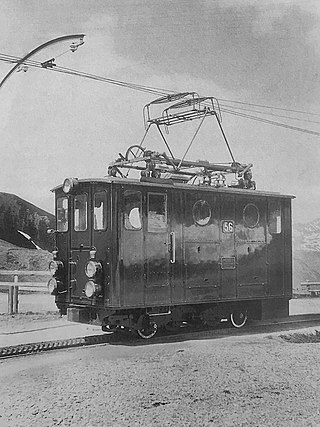
The He 2/2 51 to 58 of the Wengernalp Railway, abbreviated WAB, are electric rack railway locomotive for 1500 volt direct current and a track gauge of 800 mm. They were built in 1909 and 1910 on the occasion of the electrification of the railway lines Lauterbrunnen–Wengernalp–Kleine Scheidegg as well as Grindelwald–Grindelwald Grund–Kleine Scheidegg and served as a model for the largely identical locomotives that were subsequently procured He 2/2 59 to 63.
Matten bei Interlaken railway station is a railway station in the municipality of Matten bei Interlaken, in the Swiss canton of Bern. The station was opened in December 2023.

